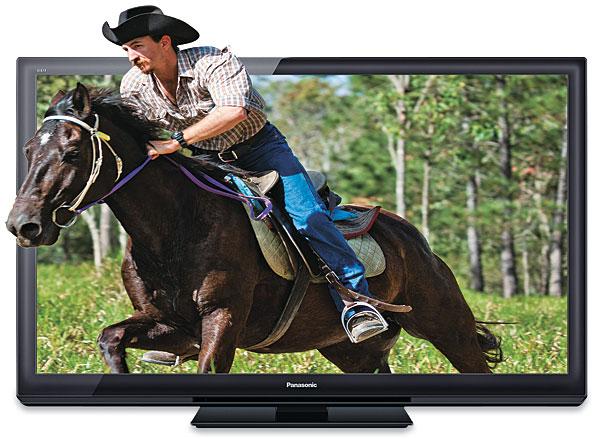Panasonic TC-P50ST30 3D Plasma HDTV

Panasonic means plasma. Yes, the company now offers a line of LCD displays, but only in smaller sizes. If you want a 50-inch or larger Panasonic, it will be a plasma. And that's not a bad thing. The TC-P50ST30 is Panasonic's latest, budget-priced, 50-inch 3D model. Only a few short years ago, you couldn't touch this level of quality in a 2D-only flat panel for five times the price—or more.
Features
As Panasonic's entry-level 3D plasma, the ST30 is not THX-certified like the mid-level GT30 and flagship VT30. It has five Picture modes: Vivid, Standard, Cinema, Game, and Custom. Apart from the Custom mode, the settings for each mode are global and cannot be adjusted separately for each input. Separate settings for 2D and 3D are restricted to the Custom mode as well.
The ST30 also has a 2D-to-3D conversion mode and a Motion Smoother. The latter provides a three-position control (Off/Weak/Strong) that can produce more fluid motion, but it makes filmed content look wrong, as we often see with these features in LCDs. Fortunately, you really don't need this, as plasmas have inherently fast response times. That is, of course, unless you like the unnaturally oily smoothness this feature can produce. I don't.
For 24-frame-per-second material, the ST30's 24p Direct In setting gives you a choice of 48Hz (frames per second, with each 24fps frame displayed twice) or 60Hz, which is selected automatically for 60Hz progressive material or interlaced sources such as 1080i. It refreshes the image at 120Hz.
Choosing 60Hz for 24fps sources adds 3:2 pulldown. Why might you do that? Flicker. Flicker was obvious and annoying on the ST30 in its 48Hz setting. To eliminate it, I used the 60Hz setting for all of my viewing, both 2D and 3D. Converting a 24fps source to 60Hz via 3:2 pulldown is normally considered bad form, but in this case, it produced no obvious artifacts. This didn't surprise me; I've done the same on reviews of Panasonic sets for the past few years (the 24p Direct In feature isn't new) and for the same reason.

The C.A.T.S. control alters the picture's brightness according to your room's lighting. But it's excessively aggressive; it limits the brightness to cataract level in a dimly lit or darkened environment. If one or more of the modes seems incredibly dim out of the box, check this control. It's probably turned on. Turn it off.
The ST30 can connect to the Internet directly or through your home network. You can connect wirelessly via Panasonic's included wireless LAN adapter, which plugs into one of the set's USB jacks. With this connection, Viera Connect (called Viera Cast on earlier Panasonic sets and on this set's remote) provides access to a growing number of Internet sites that Panasonic has partnered with, including YouTube, Picasa, Fox Sports, Amazon Instant Video, Netflix, CinemaNow, Twitter, Facebook, Hulu Plus, and Skype. By the time you read this, there could be more. For full Skype A/V operation, you'll need Panasonic's optional TY-CC10W camera ($170) or one of the alternate third-party cameras available. You can also see the images from a Panasonic security camera (not included) located anywhere in the house and linked to the set through your home network.
In addition, you can view still photos from your computer, full-motion images, and music through a connection to your home network or directly from a USB device or SD card. This includes compatible 3D content you may have captured on a 3D still or video camera.
As with most plasma sets, the ST30 has Anti Image retention features. These include a pixel orbiter that automatically and imperceptibly moves the image, an adjustment for the sidebar brightness on 4:3 sources, and a scrolling bar that can help clear temporary image retention (ghosts of images past) from the screen. As with all plasmas, a reasonable degree of caution with prolonged still images (or images that don't fill the entire screen) is advisable. There's no need to be paranoid about this, but it's smart to be extra careful during the set's first 100 to 200 hours of use. That's when the fresh-out-of-the-box phosphors are most sensitive to retention of fully stationary images, moving images with segments that don't move (such as scoreboards on sports broadcasts or video games), images that occupy less than the full screen, or particularly bright, opaque station bugs—here's lookin' at you, CNN.
Setup
After much head-scratching, hair-pulling, and mind-numbing back and forth on setup, I finally settled on using the Cinema Picture mode for 2D and the Custom mode for 3D. Custom is the only mode that provides user-menu high/low calibration settings for white balance (color tracking) plus multiple gamma selections and additional features.















































